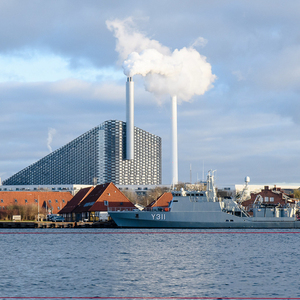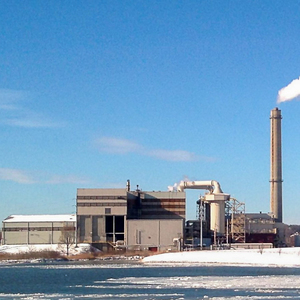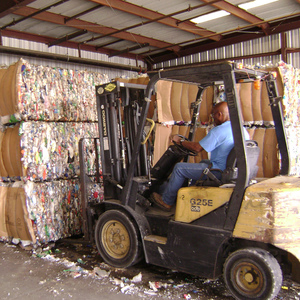
Facing streets choked with trash, the Indian city of Bengaluru is considering constructing five plants that will burn garbage to produce energy. And as garbage from around the world piles up in Indonesian ports—more than a year after China severely restricted its imports of waste from other countries—Indonesia’s president has asked cities in his country to build similar facilities, called waste-to-energy plants, in a bid to beat the growing mass of garbage. Countries like Vietnam and the Philippines are looking to Japan, home to nearly 400 such plants, for assistance in developing their own waste-to-energy infrastructure.
Garbage from homes, schools, and businesses around the globe amounted to some 2 billion metric tons (2.2 billion tons) in 2016, disproportionately discarded by people in North America, Europe, and Central Asia. Some projections say that number will reach 3.4 billion metric tons (3.7 billion tons) in 2050. Meanwhile, global energy demand climbed 2.3% last year, the quickest pace in a decade. In that context, many countries see an alluring solution in technologies that turn trash into fuel.
What exactly is waste-to-energy?
It’s a broad term whose umbrella covers a number of technologies—each of which, depending on whom you talk to, has its own drawbacks and potential.
Worldwide, waste-to-energy plants comprise nearly six out of every 10 facilities processing garbage from homes, schools, and businesses. Some 44% of the operating and soon-to-be-built facilities that process this stream of trash—called municipal solid waste (MSW)—are incinerators that burn the waste to make energy, according to the most recent United Nations report on the issue, published in 2015. About 11% use a process called gasification, with a much smaller chunk of facilities employing other methods such as pyrolysis and anaerobic digestion.
Benefits and harm
For MSW, incineration is the most common form of waste-to-energy. Unlike old-fashioned incinerators, which simply burned waste to get rid of it, waste-to-energy facilities can produce electricity. Combined heat and power generation plants, more viable in colder climates, can also make heat, which insulated pipes then carry to warm buildings directly.
The most common setup for waste-to-energy incinerators in the U.S. is what’s called the mass burn process. Trucks cart waste to a plant, and overhead cranes lift trash into a chamber where it’s set aflame and reduced to ash, most of which is landfilled (although research is turning up ways to repurpose the ash for beneficial ends). The heat from combustion turns water into steam, which is used to spin a turbine that generates electricity.
An overflowing landfill in Beirut, Lebanon, has pushed officials there to weigh the possibility of an incinerator. In Addis Ababa, the capital of Ethiopia, the city responded to a trash crisis by opening an incineration facility in 2018. As more incinerators are built in Australia, federal officials said that the facilities provided a solution for “waste that would otherwise go to landfill.”
Opponents of incineration argue that it’s far from a benign alternative to landfilling. Some claim that the practice can discourage recycling. The Zero Waste Hierarchy, created by the California-based Zero Waste International Alliance, considers incineration to be “unacceptable.”
Other critics say that incinerators spew harmful pollutants including dioxins, furans, and heavy metals, a process one observer likened to “creating landfills in the sky.” Modern incinerators can employ filtering and scrubbing technologies to limit pollution, and in the U.S. and Europe, some studies show that strict regulations have cut these pollutants. Regulations—and so emissions—vary from country to country, however. In China, for example, caps on incinerators’ dioxin emissions are similar to European benchmarks, even as fewer guidelines regulate pollutants like hydrochloric acid and nitrogen oxide, Jiang Jianguo, an expert on waste disposal technology at the Tsinghua University School of Environment, told Yale Environment 360 in 2017. Incinerators also hold the potential to be a source of toxic ash.
In the U.S., incinerators are disproportionately located in communities that are home to low-income people and people of color. A May 2019 report from the Tishman Environment and Design Center at the New School, with support from the Global Alliance for Incinerator Alternatives (GAIA), found that nearly 80% of U.S. incinerators are in areas where more than one-fourth of the population is low-income, non-white, or both.
In Minneapolis, Minnesota, one of those incinerators is in the North Loop, a recently gentrified and mostly white neighborhood next to the city’s downtown. But prior to recent development in the North Loop, historically concern about proximity to this facility has been for the city’s north side, home to many Black, Hmong, and Lao residents, and an area where Black, Latino, Asian American, and Native American poverty rates are all above 40%.
The Hennepin Energy Recovery Center (HERC) burns garbage from the city and nearby suburbs, producing “enough electricity to power 25,000 homes,” according to Hennepin County, which owns the facility. Great River Energy, the company that operates the facility, said in a December 2018 press release that the HERC keeps 331,000 metric tons (365,000 tons) of trash out of landfills each year. Opponents of the plant point to air pollution in North Minneapolis and high rates of asthma hospitalization among its residents.
In Baltimore, Maryland, a city whose population is over 60% Black, the city council moved in 2017 to lower nitrogen oxide emission limits for the area’s incinerator, citing asthma attacks among residents as justification. In Long Beach, California, government inspections found ash produced by the incinerator—which is near low-income neighborhoods—on roads and in sewage drains.
Similar concerns have spurred opposition to incineration in many other parts of the globe, including the United Kingdom, China, and India. In July, British activists blocked the first waste deliveries to a newly constructed incinerator in Gloucestershire, the latest in almost a decade of demonstrations against the project. An hour and a half southwest in Barton Stacey, thousands of people have signed a petition against plans for a rural incinerator that would be operated by Wheelabrator, the same company in charge of Baltimore’s waste burning plant. In some parts of the UK, recent protests have pushed officials to reject incinerator proposals.
This past summer in central China, thousands of people marched to protest potential plans for an incinerator near Wuhan. The country already is home to more than 230 incinerators, including the world’s largest.
In Delhi, India, hundreds of people gathered to protest one of these plants earlier this year, according to Indian environmental magazine Down To Earth, continuing nearly a decade of local opposition to the Okhla incinerator. Middle class residents concerned about the incinerator’s impact on air quality have found common cause with people who work in Delhi’s informal waste management sector. These workers, also called waste pickers, gather reusable waste and resell it—a job threatened by the incinerator’s operation.
“Since we don’t have any other work we are forced to do this filthy work. We are forced to pick up this waste,” one worker told a pair of researchers in 2014. “Still the government is trying to force us out. They want to produce electricity by burning our livelihood.”
Locked into trash
These facilities don’t just make electricity. They can also make money for the companies that operate them, with the total global waste-to-energy market projected to reach revenues of $45 billion over the next eight years, according to a report from market analysis firm Research Nester.
But incinerators are expensive to build and operate, so contracts between companies and cities typically include a provision requiring cities to supply a minimum amount of garbage—or pay a penalty. “It basically locks cities into business-as-usual waste generation,” says Claire Arkin, communications coordinator for GAIA. She says that contracts can create a situation where city governments are “penalized for failing to be wasteful enough.”
Indianapolis, Indiana, for instance, had to pay up unless it handed over an annual 272,000 metric tons (300,000 tons) of trash to Covanta, the New Jersey-based company that operated the municipality’s incinerator, according to IndyStar. While the contracted trash target has been reduced to 236,000 metric tons (260,000 tons), it cost the city at least $2.3 million while it was at the old level.
Earlier this year Wheelabrator sued Baltimore County, alleging that in 2018 the county fell short of its contractually obligated trash transfer by nearly 60,000 metric tons (66,000 tons). The company is seeking more than $32 million in damages, according to The Baltimore Sun.
Renewable energy?
In some places, incinerators receive the benefits of a powerful label: green energy.
Baltimore’s waste-to-energy plant, for instance, has received more than $10 million in state subsidies after a 2011 law designated trash incinerators as sources of renewable energy. Australia’s federal government has a similar law, opening up grant funding opportunities for the facilities.
In Oregon, Covanta has announced that it will close its Marion County incinerator unless the state legislature follows the lead of places like Maryland, a change that could net the company an extra $5 million per year by permitting it to sell its electricity at higher rates.
Across the Atlantic, under the 2009 Renewable Energy Directive, the European Union grants the renewables label to energy produced by burning waste. The renewable label doesn’t apply to materials like plastic, though, it only counts for waste of biological origin.
Ingrid Behrsin, a geographer at the University of California, Davis, urges caution when thinking about burning waste as a renewable energy source. “It’s a very complicated classification,” she says. While the waste fueling incinerators in the EU is in theory supposed to be separated by source, she says, it’s difficult to regulate in practice. When reporting their efforts to meet renewable energy targets, EU member states have to estimate what fraction of energy produced by incinerators actually stems from biogenic materials like food waste and paper, and what fraction comes from other sources such as plastic.
One scientist Berhsin interviewed in her research said that figuring out that fraction is “practically impossible.” Much of the trouble lies in finding a representative sample: The proportion of biogenic waste to other waste may fluctuate over time in a single facility, and vary across regions, making it extremely difficult to pin down a single number.
“The science behind waste-to-energy regulation is not irrefutable,” Behrsin says. In her view, that complexity opens space for “more democratic conversations” about how to regulate these technologies—conversations that can directly include “people on the ground” in making decisions about what should count as renewable.
In the EU, Behrsin says, that could entail involving communities in shaping the Renewable Energy Directive. In the U.S., that might mean inviting people who are most affected by incineration plants to help craft renewable portfolio standards.
In The Conversation, Ana Baptista, an assistant professor of environmental policy and sustainability management at The New School and co-author of the Tishman Environment and Design Center’s May 2019 report, writes that in the U.S. “burning trash will increasingly become obsolete.” Pointing to city and state climate change and sustainability goals, she writes, “Waste reduction and diversion will play a critical part in meeting these targets. The public is increasingly demanding more upstream solutions in the form of extended producer responsibility bills, plastic bans, and less-toxic product redesign. There is also a growing movement for less-consumptive lifestyles that favors zero-waste goals.”
Yet, according to projections by the World Bank, the world’s output of municipal solid waste could grow from 2 billion metric tons (2.2 billion tons) to 3.4 billion metric tons (3.7 billion tons) over the next 30 years in a business-as-usual scenario, meaning that waste-to-energy plants, including incinerators, seem poised to at least remain part of the picture. That number demands a response—whether the solution is to double down on incineration, shift toward other waste-to-energy technologies, boost recycling, or push for less waste in the first place.
Weekly Newsletter
Get building science and energy efficiency advice, plus special offers, in your inbox.















9 Comments
This article didn't answer its own question, "Should we generate energy by burning our trash?" Additionally, the question should have begun, "Should we generate electricity..."
>"This article didn't answer its own question..."
There are no simple answers to that question.
The answer is different depending on which "...we..." is being discussed.
In most cities in India trash is often incinerated in the street or backyard pits for disposal, with far greater local pollution impact than if it was picked up and incinerated in a better controlled more complete combustion process in a steam boiler for power production. So for the Bengaluru example used in the first paragraph trash-to-energy is almost certainly a net win for everyone.
In many US cities it might not be. Air pollution regs are much more stringent here, and the air is already a lot cleaner than most Asian cities.
If the trash will sit in landfills for a 1,000+ years, it should be burned to generate electricity. What good does it do sitting in growing landfills, polluting the ground water and soils, for 1,000 years? Either recycle it or burn it.
Better yet, send it to Mars. Elon Musk wants to terraform the planet and since Mars lacks proper C02 levels, send Mars the trash and dump as much C02 on Mars as possible. Then Musk and his cult followers can board a spaceship and inhabit Mars.
Carbon sequestration. Btw...some industries can use the methane gas given off by landfills for power generation so not all is lost. In any case it's not like burning garbage is somehow going to reduce the amount of trash dumped in the oceans.
We have one 3/4 of a mile from where im standing now. Lets just say, its not what it was supposed to be. ENTSORGA
Perspective from Greenland
The current state of trash disposal in most of Greenland’s towns and villages is simply to pile it up at one end of town and hope the wind doesn’t blow it too far. There was previously a lot of open pit burning, but the government correctly realized this was emitting all the toxic substances mentioned in the article.
The capital, Nuuk, has a modern waste to energy incineration plant that provides district heating to nearby buildings including an indoor public pool. The city is noticeably cleaner than the smaller towns and the lack of open garbage dumps is certainly part of this.
Greenland is of course largely ice covered, and the ice free sections are largely exposed rock - this makes the sort of landfill common to the US impossible.
Greenland’s medium term plan is to build two additional waste to energy plants In other towns and ship the waste from smaller towns to these new plants. While this sounds crazy - shipping trash around - the ships that would be carrying the trash would be dropping off goods and returning with trash. Currently the ships simply return empty or well below capacity.
From all this I think waste to energy makes tons of sense in Greenland, but it is also a very unique place with very limited space for landfills and almost entirely dependent on energy imports except where they’ve built hydroelectric.
Crazier than NYC's poop train to Colorado?
Burn, landfill, reduce, etc. Picking one is polemical. Blending all for best overall results is engineering.
Wow, waste to Energy has a long rocky past.. When I was a young attorney in the 1980s I worked on the financing of a number of these facilities. In those days, the issue was high oil priced and a desire to get away from foreign oil and that landfills were filling up. But there was always local opposition. We financed one facility in Vermont and the governor changed her mind after it was built. The plant was shut down after a year or so and sits dormant to this day. Then the Supreme Court invalidated many of the contracts that required municipalities to send their waste to the plants. Almost every plant in NJ went bankrupt as municipalities rerouted their trash to Pennsylvania where it was dumped in mines and landfills that seem to have no end. I am surprised any more plants will be built. Few people want to live downwind and disposing of the ash is difficult. Besides, energy prices are so low I doubt these plants compete economically.
Interesting article. Though I find it surprising that is does not once mention the CO2 that is produced by burning trash.
Log in or create an account to post a comment.
Sign up Log in